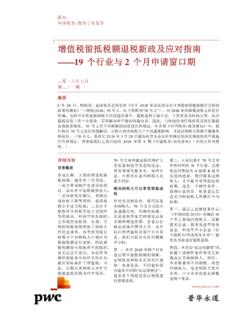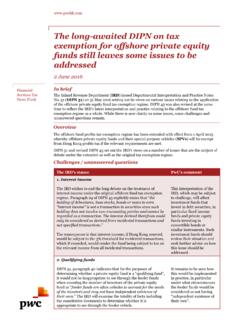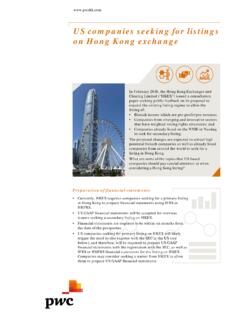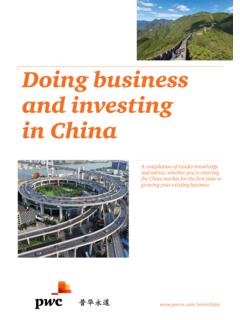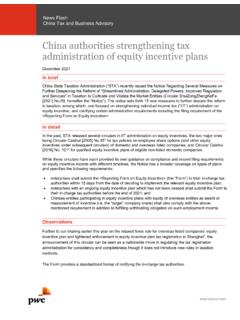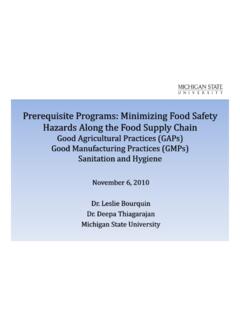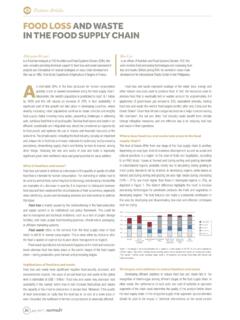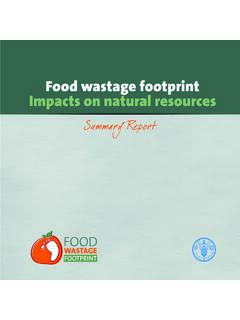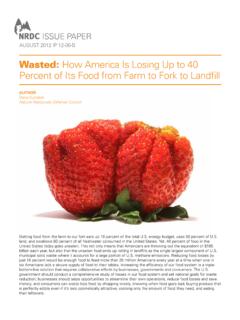Transcription of Building a Stronger Food Safety Culture - PwC CN
1 Building a Stronger food Safety CultureCommitment that goes beyond compliance When employees, managers and leaders feel personally committed to food Safety , they will do the right thing even when nobody is watching, even when it is not the cheapest or fastest approach. A strong organisational Culture can help create and sustain that commitment. Over time, good food Safety practices become the normal way of doing things and a source of personal pride. To maintain a strong food Safety Culture , leaders must not only demonstrate their commitment with their own words and actions, they must also make sure that their company s policies, systems and processes incentivise good food Safety decisions and behaviours at every level of the , companies and regulators have depended on training, inspections, audits and testing to ensure compliance with food Safety regulations and certification requirements. Training is a vital part of food Safety management, but knowledge is not always a strong driver of behaviour.
2 Inspections, audits and testing are also necessary, but they identify problems after the fact and depend on fear of detection and penalties to incentivise compliance. In the long run, companies whose management and staff make food Safety a top priority in their daily operations will enhance their profitability by preventing accidents that harm consumers, avoiding millions in recall expenses and earning public trust in their brand. 2 The time for actionBest-in-class companies do not wait for a food Safety scandal to improve their organisation s Culture . They regularly assess their Culture and take action to correct deficiencies. Their organisational Culture objectives are regularly updated to ensure alignment with their company s vision, values and strategy. Organisational culture3 Organisational Culture is the self-sustaining patterns of feeling, thinking, believing and behaving that determine how things are done around here . It is both determined and characterised by a set of formal and informal elements that we refer to as the organisation s DNA.
3 1 Organisational DNAF ormalInformal Standard operating procedures Governance forums Decision processesDecision rightsNorms Unwritten rules Values & standards Expectations Pay Career path TalentdevelopmentMotivatorsCommitments What people really care about Individualgoals & aspirations Sources of pride KPIs Metrics KnowledgemanagementInformationMind-sets What people assume Shared identityand beliefs Common language Organisation charts Job descriptions Business processesStructureNetworks How people connect Relationships Lunchgroups, sports teams1. Strategy&, Enabling change with Culture Sources: PwC, 10 Minutes on organizational DNA; Strategy&, Enabling change with Culture 4 The formal DNA elements are the visible and concrete tools for realigning your operating model they can be precisely articulated and codified. For each of the formal elements, there exists a corresponding informal DNA element that is embedded in the organisation s Culture .
4 Although less tangible and harder to wield than the formal elements, an organisation s informal elements can have an even more profound impact on execution because they directly influence workplace habits and relationships. Informal elements include the following:2 Norms are the organisation s unwritten rules and unofficial values, standards and expectations. Although not codified, taught or measured, they are firmly established, everyone understands them, and they govern the way people experience their work. These are very hard to change, but very powerful if you succeed in changing the aspirations employees have for themselves and the organisation. They are informal complements to motivators and like motivators can be both positive and ways of thinking, deeply held beliefs and unspoken assumptions that are prevalent in every organisation. They can help people make sense of information, but they can also contribute to group think. Networks are webs of direct personal connection, lunch friends, sports teams, interest groups and new-hire cohorts.
5 These can often be more powerful than the lines and boxes of the organisation PwC, 10 Minutes on organizational DNA 5 Easily identifiable markers that may be fleeting in the face of changing environmental conditions Externally facing cues that capture the attention of customers Behaviouralmanifestations of learned responses that are durable but subject to adaptation Patterns of overt behavioursand interactions Ingrained approaches to performing tasks and solving problems both within and beyond the organisation Thoughts, feelings, and beliefs that are responsive to changes in behaviourbut difficult to influence directly Defining stories that anchor a sense of collective identity in a common understanding SymbolsThoughts, feelings, beliefsBehavioursFor Culture change to endure, these must evolve but this can rarely be done directly. visibleinvisibleFocus on changing behavioursChanging symbols alone will not change people's beliefs or behaviours.
6 Culture changeThe more targeted your Culture change initiative, the greater your likelihood of success will , feelings and ways of thinking are powerful and lasting drivers of behaviour, but these are difficult to measure and even more difficult to change. We recommend that organisations focus on changing behaviours; these changes can immediately improve outcomes, and can influence beliefs, feelings and thinking over time. Source: Strategy&, A perspective on organizational Culture Formal levers for Culture changeVision, values, and strategySignal the organisation s core commitments and align actions with a common view of the future Capability system Defines core knowledge, tools, and processes and the corresponding behaviours that are crucial for execution Reporting structureEnable and constrain particular ways of working within the lines and boxes Decision rights Shape feelings of accountability and ownership and perceptions of organisational cohesion and bureaucracy Business processes and metrics Determine the operating behaviours and outcomes that are most important and should be attended to Recruitment and selection programmes Convey aspects of organisation s personality and signal individual attributes that are valued Training and LD/OD programmes Impart skills and ideas that enable behaviours and help determine feelings of reciprocal commitmentPerformance management Communicates what is valued in terms of individual contributions.
7 Exerting a strong influence on behaviour Compensation Reinforces behaviours that are rewarded and shapes perceptions of fairness and levels of commitment Internal communications Call attention to events, priorities, etc., sending key messages through content and delivery choices PoliciesDo s and don ts that formally guide how people are expected to operateIdentify which groups are the most relevant to your targeted behaviours. Work with the individuals who will be the best carriers of your of your cultural priorities, as reflected in their behaviours, feelings, beliefs and thinking. We also recommend focusing on the moments that matter, the specific interactions and decision points that have a disproportionate effect on outcomes. PwC has identified more than 15 of these activities that the largest potential impact on food Safety . When planning a Culture change initiative, one must select the most appropriate formal levers of change. These are relatively easy to change as they are visible and documented, although implementing and cascading these changes through a large organisation can be complex.
8 Examples of using formal levers include the following: articulating the value and priority of food Safety in the company s strategy, value statements and training content; ensuring that employees at every level are empowered to stop a shipment or a process in order to address food Safety issues; using compensation and other performance management means to incentivise good food Safety decisions and behaviours. 6 Source: Strategy&, A perspective on organizational Culture Tone set by senior leaders Establish a drum beat and shape perceptions about espoused behavioural prioritiesBehaviour change proof pointsProvide evidence that change is possible and/or gaining traction in the organisation Meaningful manager-employee connections Foster personal, credible relationships that can align cultural perceptions up and down the organisation Knowledge transfer Transmit key Culture messages within and beyond silos, spreading perceptions across the organisation Informal networks Sustain flows of trust, energy, and information that strongly shape cultural beliefs and behaviours Peer-to-peer interactions Influence perceptions and behaviours through informal dialogue and collaboration Communities of common interest Reinforce common identity and shape members perceptions about the larger Culture Pride builder initiatives Engage front-line leaders in efforts to define.
9 Support, and drive cultural priorities/key behaviours Culture Carriers and change agents Signal behaviours and ways of working that the organisation values, and help spread them locally Artifacts Basic layout, resources, and aesthetics that subtly communicate the values of an organisationChoosing informal levers for Culture change will require more creative thinking and thoughtful implementation. These could involve targeted events, team Building activities, contests, awards, music, videos, interactive social media content, etc. that foster the values and behaviours that are being promoted. Be sure to make both rational and emotional appeals, as feelings, beliefs and thinking can have more influence on behaviour than rules or procedures. Rational appeals build understanding of why change is needed, while emotional appeals foster acceptance and support. For example, a rational appeal might explain how better food Safety practices protect consumer health and reduce recall costs.
10 An emotional appeal might involve employees sharing their own feelings about the importance of providing their family members with safe, trusted food . Companies should identify their key influencers, those whose behaviour and demonstrated values are aligned with those to which the organisation aspires. Culture change efforts should work through those influencers who are in a position to make the largest impact on the targeted behaviours. 7 Informal levers for Culture changeSource: Strategy&, A perspective on organizational Culture Six elements of the PwC food Safety Culture FrameworkPwC has identified six organisational elements and several additional sub-elements that have the greatest impact on food Safety Culture . Each of these can either facilitate or hinder the development of a mature food Safety Culture and the achievement of food Safety objectives. food Safety Culture Framework and Assessment Tools8 LeadershipCorporate strategy & reputationPeople capabilitiesOrganisationInformationProce sses & policiesFood Safety culture9 Examples of formal elements, organisational behaviours and traits associated with mature food Safety cultures food Safety is clearly defined in the corporate strategy with tangible measures.

